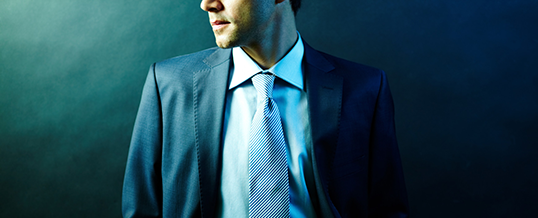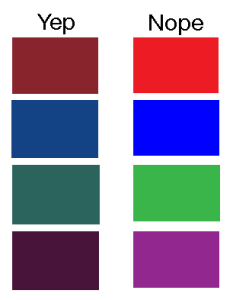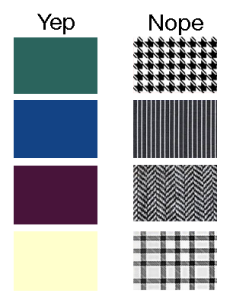
Confession: I’m not a stylish dude. I often rely on my better half to “consult” on what I’m wearing, and when we film narrative content, I always try to collaborate with a Wardrobe Stylist to make the cast look their best.
But when we shoot a corporate video or an interview, having a Stylist on set is rarely practical. As such, we often get asked “What should I wear on camera?”. It’s an excellent question, as the wrong wardrobe can distract the audience from the subject matter, and can even end up ruining a great video!
If you’re appearing on camera any time soon, check out the handy guide below. And don’t worry, this comes from experience, not my fashion-sense.
Luckily, there are some cardinal rules for on-camera clothing, and it all boils down to this: you want your audience to pay attention to your face and your words. Keep your outfit simple, tasteful, and not distracting. Muted colours, no patterns, and low contrast outfits are best.
COLOUR
We always encourage our subjects to wear colour. It helps them pop on camera, and gives them a friendly, approachable look. When wearing colour, avoid reds and oranges as they tend to look super-saturated and distract from your face, as do bright colours. Instead, go for pastels, muted colours, jewel tones or even greys. For those who don’t know what a “jewel tone” is, refer to this scientific chart:

Avoid Wearing Whites
They can reflect too much light and distract from your face. White dress shirts under a suit are ok as a last resort, but wear a pastel or cream-coloured shirt if possible.
Avoid Wearing Blacks
They can absorb too much light and can lose detail, making your clothes look like a black void. It’s a great look if you’re going for the Sauron/Angel of Death look, but not ideal for most situations.
Avoid High Contrast
To make you look your best, we set our cameras’ exposure to your skin tone, but sadly, cameras can’t capture a wide range of contrast like the human eye can. So if you have dark skin, avoid very light/white clothing. If you have light skin, avoid dark/black clothing.
Avoid Shiny Fabrics
Human eyes are naturally drawn to faces…but are even more drawn to shiny anythings.
PATTERN
Solid colours are usually preferable, but if your inner stylist begs for something more, make sure the pattern on your clothes is simple and loose. Tight, complex patterns such as pinstripes, corduroy, polka dots, herringbone and busy plaids create an insanely distracting “moiré” effect, which shifts and vibrates onscreen as you move. You can see an example of moiré aliasing in this (obnoxiously-long) video.
Another super-technical chart:

STYLE
No Logos
Don’t wear any logos on your clothing without the express permission from the copyright owner of said logo. A perfect shot can become entirely unusable if it infringes on copyright. What if you really want to show off that Nike swoosh? Just Don’t Do It (sorry).
Keep it Appropriate
Unless you’re speaking about fashion, try to avoid flashy style with your wardrobe. Again, cater your outfit to be as distraction-free as possible. A timeless look is always classy, and ensures your video won’t feel outdated in a few years.
Dress the part. Even though you may be speaking as yourself, you’re still playing a “character” in a sense. Are you speaking as a professional? A casual trend-setter? A mechanic? Dress for it, and you’ll instantly give credibility to your words.
Keep it Clean
Finally, a few obvious tips worth noting: make sure your clothing is clean, unwrinkled, and fits you well. You’ll be making a first impression to a lot of your audience, so be sure to look your best!
ACCESSORIES
Shoes
Filming can take a while and can involve long periods of standing. Make sure your shoes are comfortable and, unless you’re in fashion or selling shoes, keep them simple and not distracting.
Jewelry & Tie Clips
Feel free to wear jewelry or a tie clip, but keep it simple. Avoid anything shiny that may draw the eye, and make sure your jewelry won’t dangle, jingle or rattle. If in doubt, bring options with you.
Makeup
If there’s something Matt and I know less about than fashion, it’s makeup. So if we can only have one other person on set, it will always be a Makeup Artist. However, if you find yourself doing your own makeup, keep it simple, avoid bright lipstick or any shiny/sparkly foundation, and bring some options if you can.
Hair
Our makeup team generally focuses on hair as well, but if you have a certain style you like, follow the standard “distraction-free” rules. Keep it simple, try to avoid a style that leaves a lot of flyaway hairs, and make sure your hair and its shadows stay out of your face.
Ties & Pocket Squares
If you want to rock some red, a tie is one place where you can sneak a little bit in. But as with any clothing, make sure ties and pocket squares are subdued, not shiny, have loose patterns, and don’t steal the focus away from you.
Glasses & Sunglasses
Glasses are a fearsome foe to filmmakers. While we always prefer our subjects not wear them, sometimes they’re necessary or they fit the character or the style etc. If you must wear glasses, try to wear some glare-free lenses (we want to avoid showing the crew in those reflections!). Sunglasses are always a big no-no — the eyes are windows to your personality, let us see them!
Share
FEB

About the Author:
Scott Westby is a Writer, Director and Producer in Calgary's film industry. He's a 2008 graduate of SAIT's Film & VIdeo Production Program, and has years of experience in strategic marketing and content creation for traditional and new media. A Taco/Slurpee enthusiast and a hater of mushrooms.